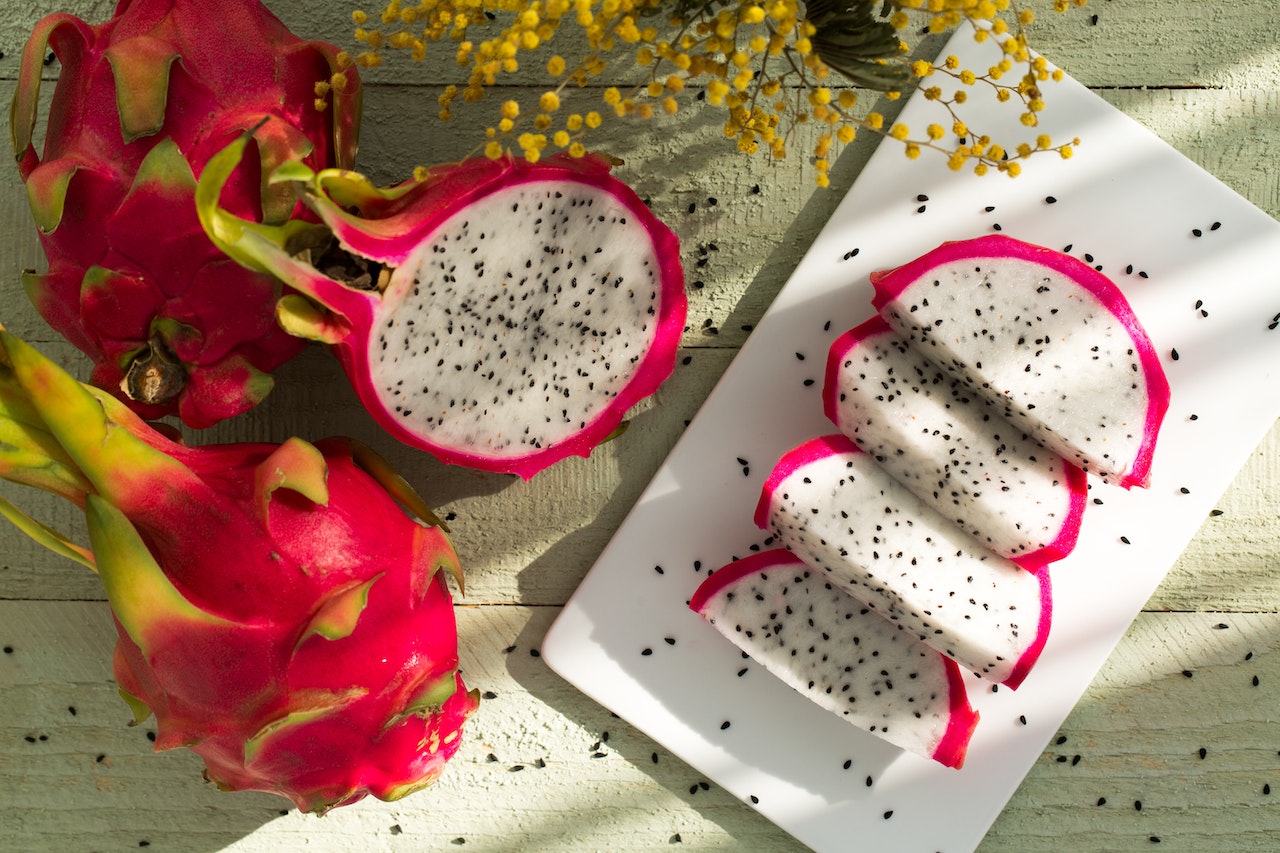The price of dragon fruit in India can vary depending on factors such as location, seasonality, and market conditions. Generally, dragon fruit tends to be relatively expensive compared to other fruits due to its imported nature and limited cultivation in India. However, prices can range from around ₹100 to ₹300 per kilogram, depending on the variety and quality.
Here are some key facts about dragon fruit
Appearance
Dragon fruit has a vibrant and distinct appearance. It typically has a bright pink or yellow outer skin with scales or spikes, resembling a dragon, hence the name. The inside flesh is usually white or red with tiny black seeds.
Varieties
There are several varieties of dragon fruit, but the most common ones are the white-fleshed and red-fleshed types. The white-fleshed variety is sweeter and milder in flavor, while the red-fleshed variety is slightly tangier and often more visually appealing.
Taste and Texture
Dragon fruit has a mildly sweet flavor with a subtle hint of acidity. Its texture is often compared to that of a kiwi, as it is juicy and filled with tiny, edible black seeds. The flesh is soft, similar to a melon, and the taste can vary slightly between different varieties.
Nutritional Benefits
Dragon fruit is low in calories but packed with essential nutrients. It is a good source of fiber, vitamin C, antioxidants, and several minerals like iron, calcium, and phosphorus. It is also rich in beneficial plant compounds like flavonoids and betacyanins, which contribute to its vibrant colors.
Health Benefits
Regular consumption of dragon fruit may offer various health benefits. It can help boost the immune system, improve digestion, promote healthy skin, and aid in weight management. The antioxidants present in dragon fruit can help reduce oxidative stress and inflammation in the body.
Culinary Uses
Dragon fruit can be enjoyed in various ways. It can be eaten fresh by scooping out the flesh with a spoon. The fruit is often used in fruit salads, smoothies, and juices due to its appealing color and mild taste. Dragon fruit is also used in desserts, such as sorbets, puddings, and cakes.
How to Select and Store
When choosing dragon fruit, look for fruits that have bright, evenly colored skin and are slightly firm to the touch. Avoid fruits with excessive blemishes or soft spots. Dragon fruit can be stored at room temperature for a few days or in the refrigerator for up to a week.
Dragon fruit nutrition value
Dragon fruit is not only visually appealing but also packed with nutritional benefits. Here is an overview of its nutrition value per 100 grams of dragon fruit:
- Calories: Approximately 60-70 calories
- Carbohydrates: Around 9-14 grams
- Fiber: Roughly 1-2 grams
- Protein: Approximately 1-2 grams
- Fat: Minimal, usually less than 1 gram
- Vitamin C: Rich source, providing 20-30% of the daily recommended intake
- Calcium: Around 1-2% of the daily recommended intake
- Iron: About 1-2% of the daily recommended intake
Dragon fruit health benefits
Now, let’s explore some of the health benefits associated with consuming dragon fruit:
Rich in antioxidants
Dragon fruit contains various antioxidants that help combat oxidative stress, reduce inflammation, and protect against chronic diseases.
Good source of vitamin C
Vitamin C plays a crucial role in immune function, collagen production, and wound healing. Dragon fruit provides a significant amount of this vitamin, contributing to overall health and immunity.
High in fiber
The fiber content in dragon fruit supports healthy digestion, aids in maintaining bowel regularity, and promotes satiety, which can be beneficial for weight management.
Potential blood sugar regulation
Dragon fruit has a relatively low glycemic index, meaning it does not cause a significant spike in blood sugar levels. This characteristic makes it a suitable option for individuals with diabetes or those aiming to manage their blood sugar levels.
Hydration and electrolyte balance
Dragon fruit has a high water content, helping to keep the body hydrated. Additionally, it contains electrolytes such as potassium and magnesium, which are essential for maintaining fluid balance and proper muscle function.
May promote heart health
Dragon fruit contains certain compounds, such as antioxidants and monounsaturated fats, which may contribute to heart health by reducing the risk of cardiovascular diseases.
It’s important to note that while dragon fruit offers several health benefits, it should be consumed as part of a well-balanced diet and a healthy lifestyle. Individual nutritional needs and health conditions may vary, so it’s always recommended to consult a healthcare professional for personalized advice.
The most common types of dragon fruit
Hylocereus undatus
This is the most widely cultivated type of dragon fruit. It has a vibrant pink or magenta skin with green scales and white or pink flesh speckled with small black seeds.
Hylocereus costaricensis
Also known as the Costa Rican pitaya or red-fleshed dragon fruit, this variety has a bright red or deep pink skin with green scales and red or magenta flesh. It is slightly sweeter than the white-fleshed variety.
Hylocereus megalanthus
Often referred to as the yellow dragon fruit or yellow pitaya, this variety has a bright yellow or golden skin with green scales. Its flesh is white with small black seeds and has a sweeter, milder flavor compared to other dragon fruit varieties.
These are the most common types of dragon fruit, but there are also other less common varieties and hybrids with different colors and characteristics. The taste and texture of dragon fruit are often described as a combination of kiwi and pear, with a mildly sweet flavor and a refreshing, juicy texture.
